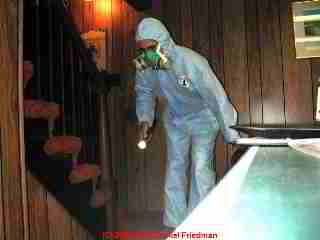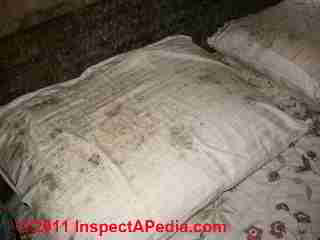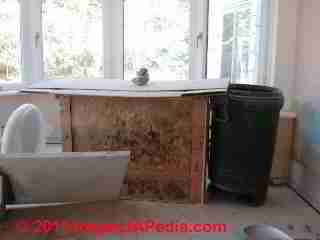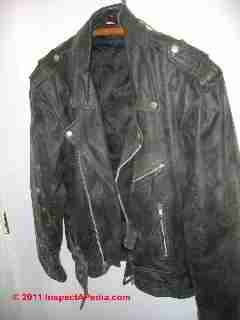 Moldy Musty Smells in Buildings
Moldy Musty Smells in Buildings
Causes & cures
- POST a QUESTION or COMMENT about finding & removing mold odors in buildings, furnishings, clothing, other items.
Mold & Musty Smells Explained: this web article summarizes the common sources and causes of moldy and musty odors in buildings.
Here we explain the causes & cures of moldy smells & odors in buildings. We discuss how to track down a moldy smell to its source, possible health hazards where there are mold smells & MVOCs in buildings, and we describe how to clean out or remove moldy odors from buildings, furnishings, clothing, etc.
This website provides articles on to diagnose, test, identify, and cure moldy musty odors in buildings.
InspectAPedia tolerates no conflicts of interest. We have no relationship with advertisers, products, or services discussed at this website.
How to Recognize, Identify, & Remove Moldy Musty Odors in Buildings
 Mold Smell Basics - What You Need to Know
Mold Smell Basics - What You Need to Know
Why do we smell a variety of different odors indoors, maybe from mold or from other sources? How to identify odors or gases by type, source, and toxicity. Noxious odors or smells in buildings can be diagnosed and cured. Environmental safety advice for home owners & home buyers. Un-biased mold and mold odor removal advice from a neutral party.
- If you smell mold or "mildew" there's probably mold in the building.
Most people correctly identify moldy or musty smells as "mold". Some folks call these odors "mildew-odor" but since mildew grows only on living plants, it's more accurate to call these indoor odors and growths "mold". - Not all mold makes moldy smells.
So problem mold may be present but not smelly. Don't rely on odors alone to decide whether or not there is a mold problem in a building. - Mold smells are not necessarily dangerous but they indicate a problem.
There have been suggestions that mold VOC's may be harmful and certainly some of our clients have that opinion.
Some scientific studies confirm MVOC worry - depending on just what is airborne in a building.
Since if there is a mold odor there is will be one or more mold colonies in a building, we don't know if medical or other occupant complaints are really due to the odor or due to exposure to mold spores, allergens, or toxins. - If there's mold in the building it should be found, removed, and its cause corrected.
- Costly mold inspection/testing may not be appropriate.
See MOLD / ENVIRONMENTAL EXPERT, HIRE ? - Removing problem mold may not remove all moldy odors.
Mold "odors" are probably MVOCs (Mold Volatile Organic Compounds) but these gases can permeate other soft goods like carpets, clothing, curtains, upholstered furniture and can be difficult to remove, though thorough cleaning and exposure to sunlight and fresh air will usually remove the worst of these odors.
Single individual mold genera/species may produce different moldy musty odors
 There are some mold genera/species that produce a variety of odors (MVOC’s) depending on varying conditions of moisture and also what the molds are growing on, as well as producing odors only under certain conditions (particularly with variations in temperature and humidity, and perhaps light).
There are some mold genera/species that produce a variety of odors (MVOC’s) depending on varying conditions of moisture and also what the molds are growing on, as well as producing odors only under certain conditions (particularly with variations in temperature and humidity, and perhaps light).
Our photo (left) illustrates that the source of a mold smell in a building may be hidden from view - in this case there was extensive mold found growing on the back (hidden side) of kitchen cabinets. The cabinet shown was removed to show the problem.
Different mold genera species may produce different moldy musty odors
There are building conditions that produce a variety of growing mold species - in a moldy building it is very likely that there are multiple species growing on various mold-friendly materials.
Some mold colonies can be hard to spot. Certainly different species of mold respond differently to temperature, moisture, and nutrients they find. For example, one mold species is referred to as the "moldy gym socks" mold since it produces that odor.
Buildings with a moldy smell may have other odors or hazards not related to mold
Most people have a pretty good idea of moldy or musty smell as associated with mold. If you smell mold or find it at important levels in screening samples of air, dust, or vacuumed surfaces, (by quantity or by particle type in samples) it is probably there.
But it would be no surprise to find a variety of odors in a building coming from mold problems or from other problems there.
There can be lots of other odor sources in a building, including potentially dangerous ones such as heating appliance flue gases (which might include very dangerous but odorless carbon monoxide along with smelly combustion products) in a building.
Other possible concerns that might produce strange smells include chemicals such as pesticides that may have been improperly applied. To identify other building mold odors
see ODORS GASES SMELLS, DIAGNOSIS & CURE.
Since lots of building conditions can cause odors (ranging from dead animals to sewer backups) and since some of them can be tough to track down (sun-heated plastic windows, window screens, or vinyl siding), also take a look at the links along the left of this page.
Variations in Conditions at a Building Cause Wide Variation in Mold Odors
- Humidity changes
cause mold to behave differently - species dependent, including release or not of spores, and release or not of MVOC's which is what you 're probably smelling.
I've seen a very moldy college library go from almost no airborne mold to very high airborne mold when the humidity in the moldy basement was suddenly and significantly lowered. The change in humidity alone appeared to cause the mold (Aspergillus sp.) to begin releasing spores in visible green dusty clouds. - Wind
of course might pressurize some building walls differently, causing wall cavity contents to be noticed or not. We've had reports of moldy odors coming from electrical outlets in windy weather; we postulated that wind may have been p
ressurizing the building's walls, causing moldy odors to leak into the living area from wall cavities where there was a pre-existing mold colony either on building material surfaces (wood, drywall) or in the wall cavity insulation. - Weather changes:
such as a rainy season can produce changes in mold behavior and odors. - Temperature changes
can cause mold to behave differently, in MVOC production, sporulation, or other growth stages. - Light & Other changes
might also affect mold growth and behavior, such as changes in the level of light exposure or perhaps even seasonal changes. - Mechanical disturbance
such as the agitation of moldy materials during demolition or cleaning can cause an extreme increase in the level of airborne spores and other fungal materials, and might increase the level of moldy odors as well. - Use of equipment that moves, filters, or changes the moisture level in indoor air or that intends to remove smells,
such as ozone generators, can produce other odors, not mold, but potentially indicating harmful or even dangerous conditions.
See our OZONE MOLD / ODOR TREATMENT WARNINGS article.
One cannot tell from smell alone whether the mold is a large or small area, nor can one tell by smell alone if the mold we smell is allergenic or toxic.
What to do about moldy odors in buildings
Knowing something about the history of the building and its prior occupants and uses can help point to directions of investigation. This is especially useful since there are no simple economical “catch-all” tests for chemicals or gases that cover every possible hazard.
Find the problem mold source
Follow your nose, use your eyes, but also think: where has there been a building moisture problem, roof leak, plumbing leak, sewer backup, or other moisture source. Investigate these areas by visual inspection.
Mold tests can be useful but are no substitute for a careful visual inspection and history-taking if you want to find odor problems in a building. Our website provides in-depth guidance on what to do about mold. See in particular
Individual odor sensitivity varies widely
It is certainly true that individuals’ sensitivities to odors varies quite widely. Often one person in a building or family notices odors more than everyone else, just as sometimes only one family member is bothered or made ill by mold or allergens or other building contaminants.
For example some pregnant women experience an acute increase in odor sensitivity. I’ve conducted field experiments that demonstrated a remarkably accurate ability of a pregnant woman (who complained of odors in the home) to correctly identify materials emitting a particular odor even when others in the home didn't’t notice a thing.
Illness or even medicines can cause variations in odor perception
It’s also true that some illnesses can cause perception or misperception of odors (imagining smells) while other illnesses can interfere with one’s ability to sense an odor. So a thorough approach to odor complaints would include consulting with a physician.
This is particularly appropriate if there were not an obvious in-building source, when only one person in a building perceives a problematic odor, or when someone already knows that they have an illness or complaint that may be odor-sensitive, such as Multiple Chemical Sensitivity or when someone is under particular medical treatments that may cause odor sensitivity problems to manifest themselves.
Reader Question: black mold in my garage wall left a musty smell in clothing - will the smell go away ?
 I have black mold in one wall of my garage, due to a leak. It is now
being repaired. It smelled musty for about a year and I finally am
getting around to fixing it. I use my garage as a closet for some
clothing. I notice that the ones that have been there for a long time
smell musty.
I have black mold in one wall of my garage, due to a leak. It is now
being repaired. It smelled musty for about a year and I finally am
getting around to fixing it. I use my garage as a closet for some
clothing. I notice that the ones that have been there for a long time
smell musty.
Do I need to throw them all away, or will the smell and any danger from the mold in the air that got onto the clothing simply go away in time? Many of these are clothes are vintage and have been in there for 10-20 years.
I am not going to wash them- it's either they will be fine in time or I will sadly throw them away. There are too many to wash, iron etc. and some are too delicate or ornate to wash. Thanks, R.P.
Our photo (left) illustrates a leather jacket covered in heavy white mold growth. This item was beyond economical restoration.
Reply: clean clothing to get rid of mold odors; you may have to toss out carpets & some upholtered furnishings
A competent onsite inspection by an expert usually finds additional clues that help accurately diagnose a problem that you haven't discussed such as making sure the mold cause is repaired and making sure you don't focus just on "black mold" missing other more toxic or harmful molds that can be present where wet conditions occur in a building.
That said, here are some things to consider:
The mold smell will dissipate but it is unlikely to go away, certainly not quickly and possibly never in clothing that remains enclosed, boxed, or in closets in a moldy or recently moldy smelly area. This is so even if there is no visible mold on the clothing, as fabrics absorb MVOCs - volatile organic compounds produced by many mold species under the right conditions.
Occasionally we can successfully deodorize a fabric or even a carpet by leaving it outdoors in sunlight for enough hours, but in my experience moldy-smelling clothes can best and most reliably be deodorized by being laundered or dry-cleaned successfully to remove mold and odors. On occasion I've had to run clothes twice through a washer. Or have them cleaned professionally.
If there is clothing that would be less costly to buy new than to have professionally cleaned, the choice is apparent: replace those items.
In contrast, moldy smelling upholstered furniture or carpets can be difficult or impossible to clean successfully and are usually tossed out.
Reader Question: moldy odors in a home subjected to flooding: what should I do?
I live in a property which is situated on a flood-plain (the property does flood, last back in Feb 2011) and has no damp-proofing, so I've been told. The property has a strong damp odour, especially noticeable after a few days away from the place.
My clothes and other soft furnishings (and skin) really pick up the odour, and it's quite a stench that's makes me feel a little sick (it's really noticeable when visiting other peoples' homes and not so much living in the place as if I become more habituated to the odour) and it's just not a damp smell on clothing, bed linen etc, there's a kind of burnt wood/old wet wall plaster smell as well, quite hard to explain really but not nice.
So I was wondering if you had any idea what could be going and if the odour could be carrying mold toxins/VOCs and getting into my body and could be making me gradually sick over a prolonged time (I do get painful sinuses and joint aches and pains which blood tests show negative). Should I be getting some kind of biotoxin blood test done?
And what tests should I be having done in the property? Any information and advice is welcome. - M.B. 12/20/2013
I forgot to ask about whether using fans to help control mold growth is a good idea. One of my bedroom walls collects condensation in cold weather (earlier in the year I found black mold under the wall paper so stripped the paper and painted that particular section of wall, you can now see water on the wall.
haven't a clue what's going on under the rest of the paper in the room or actually in the walls it!) and in the conservatory, having no heating collects a load of moisture, with the problem of the wall areas growing black mold.
So I like to use fans in these places to help to evaporate moisture and to help keep dry-would this be helping to spread mold spores as a family member seems to think?
Reply:
A competent onsite inspection by an expert usually finds additional clues that would permit a more accurate, complete, and authoritative answer than we can give by email alone. You will find additional depth and detail in articles at our website. That said I offer these comments in reply to your email:
1. If you smell mold, there is almost certainly mold somewhere
in the building, in quantity large enough to produce enough mold-volatile-organic-compounds (MVOCs) that you smell it.
And indeed, some people can have an allergic, asthmatic, or other healt-related problem from MVOCs - that's well documented. It's also the case that chronic exposure or even a single or infrequent but very strong exposure to MVOCs can sensitize someone so that they suffer in the future even from lower MVOC exposure.
That's been my experience as well as something corroborated by reading the literature.
From just your email no honest investigator could nor would attempt to diagnose the problem - but it sounds as if you need an expert on-site investigation to understand the building's leak history, what has been wet, where water or moisture are or have been present in the structure, where the highest risk areas are, and what mold contamination is found in those areas.
The result should be an action plan: what needs to be done to remove the problem (we remove it we don't "treat" or "kill" it), and what needs to be done to stop a recurrence.
The article MOLD / ENVIRONMENTAL EXPERT, HIRE ? - has advice on how to decide if it's justified to bring in an expert. Beware of amateurs who promise miracle cures - except for small do-it-yourself-scale mold cleanup projects, you're usually wasting your money and you may be risking making matters worse.
2. Using fans or other equipment to reduce indoor humdity
can in general reduce the tendency of a building to grow problem mold indoors, but using fans also enormously increases the level of airborne dust. So I think the first order of business is to understand what's going on with the building and what needs to be done about it.
...
Continue reading at MVOCs & MOLDY MUSTY ODORS or select a topic from the closely-related articles below, or see the complete ARTICLE INDEX.
Or see MOLD ODORS, MUSTY SMELL FAQs - questions & answers posted originally at this page
Or see these
Recommended Articles
- ACTION GUIDE - WHAT TO DO ABOUT INDOOR MOLD
- ODOR DIAGNOSIS SIX STEPS
- SMELL PATCH TEST to FIND ODOR SOURCE
Suggested citation for this web page
MOLD ODORS, MUSTY SMELLS at InspectApedia.com - online encyclopedia of building & environmental inspection, testing, diagnosis, repair, & problem prevention advice.
Or see this
INDEX to RELATED ARTICLES: ARTICLE INDEX to BUILDING ENVIRONMENT
Or use the SEARCH BOX found below to Ask a Question or Search InspectApedia
Ask a Question or Search InspectApedia
Try the search box just below, or if you prefer, post a question or comment in the Comments box below and we will respond promptly.
Search the InspectApedia website
Note: appearance of your Comment below may be delayed: if your comment contains an image, photograph, web link, or text that looks to the software as if it might be a web link, your posting will appear after it has been approved by a moderator. Apologies for the delay.
Only one image can be added per comment but you can post as many comments, and therefore images, as you like.
You will not receive a notification when a response to your question has been posted.
Please bookmark this page to make it easy for you to check back for our response.
Our Comment Box is provided by Countable Web Productions countable.ca
Citations & References
In addition to any citations in the article above, a full list is available on request.
- In addition to citations & references found in this article, see the research citations given at the end of the related articles found at our suggested
CONTINUE READING or RECOMMENDED ARTICLES.
- Carson, Dunlop & Associates Ltd., 120 Carlton Street Suite 407, Toronto ON M5A 4K2. Tel: (416) 964-9415 1-800-268-7070 Email: info@carsondunlop.com. Alan Carson is a past president of ASHI, the American Society of Home Inspectors.
Thanks to Alan Carson and Bob Dunlop, for permission for InspectAPedia to use text excerpts from The HOME REFERENCE BOOK - the Encyclopedia of Homes and to use illustrations from The ILLUSTRATED HOME .
Carson Dunlop Associates provides extensive home inspection education and report writing material. In gratitude we provide links to tsome Carson Dunlop Associates products and services.

